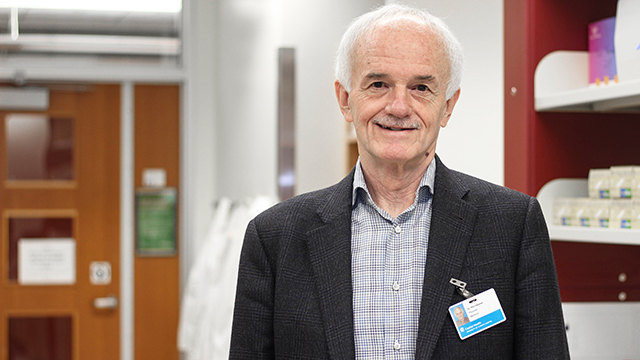
Philip Halloran's research has contributed to the dramatic drop in transplantation failure rates―from 55 to just five per cent since the outset of his 40-year career. From the causes of organ rejection and moving on to diagnosis in treatment, the professor in the University of Alberta's Division of Nephrology's work has changed the lives of countless transplant patients around the world, making him a shoo-in for the U of A's most prestigious research acknowledgment, the J. Gordin Kaplan Award for Excellence in Research in the sciences category.
Named after the university's first Vice-President, Research, the Kaplan recognizes and honours faculty members whose research contributions add significantly to our knowledge base, who are recognized nationally and internationally for their scholarly accomplishments and who set a standard of excellence for other U of A faculty, graduate and undergraduate students and the community-at-large.
Halloran's lifelong goal as a clinician-scientist is to see his research findings applied at the bedside, to improve the lives of people who have undergone a transplant. Here are a handful of his accomplishments to illustrate how he is advancing transplantation science.
1. He is disrupting diagnostic tools
Biopsy technology allows clinicians to determine the rejection stage of an organ after transplantation, but inaccurate measurements happen frequently. In order to improve accuracy of the testing, Halloran and his team have developed a diagnostic tool calledMMDx (Molecular Microscope® Diagnostic System) which improves on existing biopsy methods for transplant organs by using gene chips to measure molecules instead of cells, making the test more precise and less invasive.
MMDx was more than 30 years in the making, cost $35 million to develop and is ultimately a disruptive technology, explained Halloran.
"This is a story of a team of researchers who believed in the value of something, even though it was paradigm-changing, and who worked diligently to establish scientific foundation in order to convince medical leaders in the field of its effectiveness and to get it into the hands of the public."
2. He discovered why some organs are rejected
As a medical student, Halloran wanted to improve circumstances for the more than half of organ transplant patients at the time whose bodies rejected transplant.
"There was a poor ability to understand the immune response to organ transplants and we couldn't control rejections. There were desperate people, and a lot of lives were lost," Halloran said.
His determination eventually led to the discovery that bothT cells (T cell-mediated rejection, TCMR) and antibodies (antibody-mediated rejection, "ABMR") are some of the main culprits of organ rejection, with the help of the MMDx tool. Halloran is now recognized as defining ABMR as the major mechanism causing graft loss post-transplant.
Although there is still more to learn about why rejection happens, Halloran's ABMR discovery has led to research that will make more effective drug therapies available.
3. He is advancing anti-rejection drugs
Halloran led the development of a new companion drug called mycophenolate mofetil or Cellcept™ that improves survival rates and reduces side-effects of other drugs. According to Bruce Kaplan, professor of medicine at the Mayo Clinic in Scottsdale, Arizona, Halloran's 2004 New England Journal of Medicine review on immunosuppressive drugs is now required reading for any transplant specialist in training.
"I can say categorically, without bias, that Halloran is the most influential individual in transplantation over the past 25 years," Kaplan said.
4. He founded the Alberta Transplant Applied Genomics Centre(ATAGC)
The ATAGC is an interdisciplinary research centre located at the U of A that focuses on understanding organ disease at the molecular level. The centre provides a means for international partners from across North America, Europe, Australia, and recently Asia to collaborate on research projects and to improve human health and scientific understanding of disease across multiple health disciplines.
5. His work is putting UAlberta at the epicentre of the international transplant map
The U of A recentlyrated sixth in the world in transplantation according to a new subjects ranking by the Center for World University Rankings. Halloran and his team have contributed significantly to the university climbing the transplant ranks.
After winning the prestigious 2016 Prix Galien in Research, Halloran received aDoctor Honoris Causa from Paris Descartes University at the Musée d'Histoire de Médicine. Paris is considered to be an international home base of kidney transplant innovations, making Halloran's induction a vote of confidence from some of the world's leading transplant scientists.
Halloran says there is now a very strong Paris-Edmonton connection, thanks to this prestigious recognition. "I feel that in honouring me they were honouring the distinguished history of the University of Alberta teams in organ transplantation."